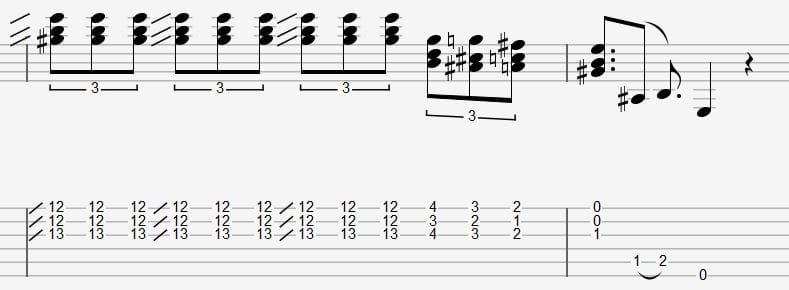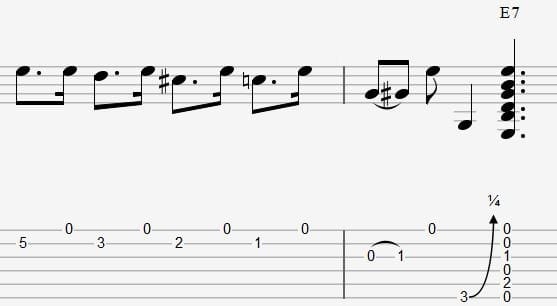Getting Started with Blues Turnarounds
GUEST POST - In this lesson we will be talking about turnarounds. Turn arounds are a staple in jazz and blues playing. Today we’ll be focused on blues turnarounds and how you can use these to enhance your blues playing today!
A turnaround is typically the last two bars of a 12 bar blues chord progression, however in some instances a turnaround can last for 4 bars. The name comes from the idea that the phrase you play “Turns around” the pattern back to the first chord. We will look at some examples that you can use in your own playing today. All the examples are in the key of E and are written over a I IV V blues in E (E, A and B being the underpinning chords here).
A turnaround in blues music can also be used to end a song.
Example 1

This first turnaround is 2 bars. The first bar alternates between a double stop on the D and G strings played as a dotted 8th note (1 e &) and a 16th note E played as a bass note just ahead of the next beat. (1 e & a 2 e & a etc.). When playing the double stops, try to keep one finger anchored on the 9th fret of the G to minimize the amount you have to move your hand for each shape. The second bar contains an ascending run on the D string ending on an E major chord.
Example 2

This turnaround is 3 bars long but the third bar can be used in two different contexts. If using this as a turnaround before continuing the chord progression, the final E chord can be substituted for the first bar of your usual rhythm. If using this turnaround at the end of a song, that final E in bar 3 can be used as the final chord.
This is a descending chord run in quarter note triplets before an open string double stop combined with a hammer on across the same triplet length.
Example 3

This turnaround follows the same chord progression as Example 2 across the first 2 bars but is executed in a different manner. The chord shapes remain the same, as do the quarter note triplet rhythms, however instead of playing the chord 3 times you will alternate between playing the G string, B & E strings together and the G again as your triplet group before descending to the next chord.
Bars 3 and 4 contain the same quarter note triplet rhythms but with a different group of notes, the first triplet is a quarter tone bend on the 3rd fret of the low E followed by 2 open E strings. This is then followed by an E7#9 chord (Any Hendrix fan will recognise this chord!) played with an E bass note between hits.
Example 4

Here is a Texas blues style turnaround. If you’re a lover of Stevie Ray Vaughan or Albert King, this is the turnaround you’ll love.
We start with a slide from the 3rd to 5th fret of the B string, played with an open E string at the same time. We’re doing 8th note triplets across the whole bar (3 notes per beat). The timing of the slide is important to maintain that Texas groove, as you hit the first note of each triplet you want to deliver a strong slide up to the second note. After 3 groupings of slide, there is a little run down to an E chord.
Example 5

This turn around is a slide guitar style turnaround similar to an Elmore James style lick except you don’t need a slide to play this.
It starts with Emaj triad (E, B, G#) played on the G B and E strings as 8th note triplets. Similar to the last turnaround, you will be sliding into the first note of each beat. The 4th beat in the bar is a descending chord pattern followed by a short lick descending to the root of E.
Example 6

Our final turnaround is a single note descending line on the B string with an open E string between. The open string should be played on the 16th note ahead of the following beat (1 e & a 2 e & a etc.). This turnaround ends with a hammer on from the open to the 1st fret of the G, a skip up to the open E before jumping down to a quarter tone bend on the 3rd fret of the low E and ending on an E7 chord. This turnaround makes a great ending to a blues progression.
These turnarounds will be a great addition to your blues progressions. Try them leading from one 12 bar repeat to another, or as a way to end a jam. Try to add a little bit of your own flavour in by changing some of the licks or phrasing and have fun!

About The Author
Leigh Fuge is a guitar teacher and professional guitar player from the UK. He has a huge passion for blues guitar and has taught countless students how to find their blues voice. He is part of https://mgrmusic.co.uk and provides online content for many high profile guitar publications.
